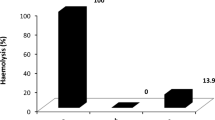Abstract
Human hemolysate was incubated in vitro with different concentrations of dichloromethane (methylene chloride). The resulting enzymatically mediated production of formaldehyde was determined by two independent analytical methods (Nash-reaction/colorimetry or HPLC). The formation of formaldehyde from dichloromethane is influenced by the polymorphism of glutathione-S-transferase (GST) Theta, in the same way as the metabolism of methyl bromide, methyl chloride, methyl iodide and ethylene oxide. Three quarters of the population (“conjugators”) possess, whereas one quarter (“non-conjugators”) lack this enzyme activity in human erythrocytes. The metabolism of dichloromethane in hemolysate in vitro can be described by Michaelis-Menten kinetics; for an individual with high GST T1-1 enzyme activity, the maximum velocity of formaldehyde production was calculated to be approximately 180 pmol/min per mg Hb, the k M being approximately 60 mM dichloromethane. Carcinogenicity of dichloromethane in long-term inhalation exposure of rodents has been attributed to metabolism of the compound via the GST-dependent pathway. Extrapolation of the results to humans for risk assessment should consider the newly discovered polymorphic enzyme activity of GST Theta. Furthermore, the possible existence of a “high-risk” population among humans should be considered in epidemiological research.
Similar content being viewed by others
References
Ahmed AE, Anders MW (1976) Metabolism of dihalomethanes to formaldehyde and inorganic halide. I. In vitro studies. Drug Metab Dispos 4: 357–361
Ahmed AE, Anders MW (1978) Metabolism of dihalomethanes to formaldehyde and inorganic halide—II. Studies on the mechanism of the reaction. Biochem Pharmacol 27: 2021–2025
Andersen ME, Clewell III HJ, Gargas ML, Smith FA, Reitz RH (1987) Physiologically based pharmacokinetics and the risk assessment process for methylene chloride. Toxicol Appl Pharmacol 87: 185–205
Anderson MW, Maronpot RR (1993) Methylene chloride-induced tumorigenesis. Carcinogenesis 14: 787–788
Bogaards JJP, van Ommen B, van Bladeren PJ (1993) Interindividual differences in the in vitro conjugation of methylene chloride with glutathione by cytosolic glutathione S-transferase in 22 human liver samples. Biochem Pharmacol 45: 2166–2169
Bolt HM (1994) Open issues in experimental developmental toxicity and carcinogenicity of dichloromethane (methylene chloride). Toxicol Environ Chem (in press)
Casanova M, Deyo DF, Heck HdÁ (1992) Dichloromethane (methylene chloride): Metabolism to formaldehyde and formation of DNA-protein cross-links in B6C3F1 mice and syrian golden hamsters. Toxicol Appl Pharmacol 114: 162–165
ECETOC (1987) Technical Report No. 26: the assessment of carcinogenic hazard for human beings exposed to methylene chloride. ECETOC, Brussels
ECETOC (1988) Technical Report No. 32: Methylene chloride (dichloromethane): human risk assessment using experimental animal data. ECETOC, Brussels
ECETOC (1989) Technical Report No. 34: Methylene chloride (dichloromethane): an overview of experimental work investigating species, differences in carcinogenicity and their relevance to man. ECETOC, Brussels
Green T, Provan WM, Collinge DC, Guest AE (1988) Macromolecular interactions of inhaled methylene chloride in rats and mice. Toxicol Appl Pharmacol 93: 1–10
Grömping A, Cammann K (1989) Some new aspects of an HPLC method for the determination of traces of formaldehyde in air. Fres Z Anal Chem 335: 796–801
Hallier E, Deutschmann S, Reichel C, Bolt HM, Peter H (1990) A comparative investigation of the metabolism of methyl bromide and methyl iodide in human erythrocytes. Int Arch Occup Environ Health 62: 221–225
Hallier E, Langhof T, Dannappel D, Leutbecher M, Schröder K, Goergens HW, Müller A, Bolt HM (1993) Polymorphism of glutathione conjugation of methyl bromide, ethylene oxide and dichloromethane in human blood: influence on the induction of sister chromatid exchanges (SCE) in lymphocytes. Arch Toxicol 67: 173–178
Hearne FT, Grose F, Pifer JW, Friedlander BR, Raleigh RL (1987) Methylene chloride mortality study: dose response characterization and animal model comparison. J Occup Med 29: 217–228
IARC, International Agency for Research on Cancer (1986) Dichloromethane. IARC Monogr 41: 43–85
IARC, International Agency for Research on Cancer (1987) Overall evaluations of carcinogenicity: an updating of IARC Monographs volumes 1–42. IARC Monogr Suppl 7
Meyer DJ, Coles B, Pemble SE, Gilmore KS, Fraser GM, Ketterer B (1991) Theta, a new class of glutathione transferases purified from rat and man. Biochem J 274: 409–414
Mirer FE, Silverstein M, Park R (1988) Methylene chloride and cancer of the pancreas. J Occup Med 30: 475–476
Nash T (1953) The colorimetric estimation of formaldehyde by means of the Hantzsch reaction. Biochem J 55: 416–421
NTP, National Toxicology Program (1986) Technical report on the toxicology and carcinogenesis studies of dichloromethane in F344/N rats and B6C3F1 mice (inhalation studies). US Dept of Health and Human Services. NIH publication No. 86-2562, NTP-TR 306
Pemble S, Schröder K, Taylor JB, Spencer S, Meyer DS, Hallier E, Bolt HM, Ketterer B (1993) Human glutathione transferase theta (GSTT1): cDNA cloning and the characterization of a genetic polymorphism. Biol Chem Hoppe-Seyler 374: 796
Peter H, Deutschmann S, Reichel C, Hallier E (1989) Metabolism of methyl chloride by human erythrocytes. Arch Toxicol 63: 351–355
Reitz RH, Mendrala AL, Guengerich FP (1989) In vitro metabolism of methylene chloride in human and animal tissues: use in physiologically based pharmacokinetic models. Toxicol Appl Pharmacol 97: 230–246
Schröder KR, Hallier E, Peter H, Bolt HM (1992) Dissociation of a new glutathione S-transferase activity in human erythrocytes. Biochem Pharmacol 43: 1671–1674
Thier R, Föst U, Deutschmann S, Schröder K, Westphal G, Hallier E (1991) Distribution of methylene chloride in human blood. Arch Toxicol Suppl 14: 254–258
Thier R, Pemble SM, Taylor JB, Humphreys WG, Ketterer B, Guengerich FP (1993) Glutathione S-transferase 5–5 expression in S. typhimurium increases mutation rate caused by methylene dihalides. Pharmacol Toxicol 73 [Suppl II]: 42
Vangala RR, Bolt HM (1993) Investigation of DNA damage in lung and liver of male B6C3F1 mice after inhalative exposure to high levels of methylene chloride. Naunyn-Schmiedeberg's Arch Pharmacol Suppl 347: R 23
Author information
Authors and Affiliations
Rights and permissions
About this article
Cite this article
Hallier, E., Schröder, K.R., Asmuth, K. et al. Metabolism of dichloromethane (methylene chloride) to formaldehyde in human erythrocytes: influence of polymorphism of glutathione transferase Theta (GST T1-1). Arch Toxicol 68, 423–427 (1994). https://doi.org/10.1007/s002040050092
Received:
Accepted:
Issue Date:
DOI: https://doi.org/10.1007/s002040050092




